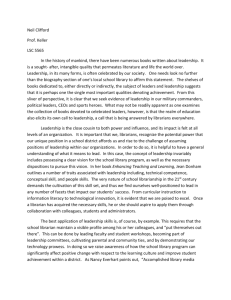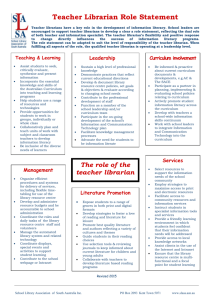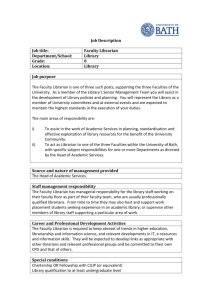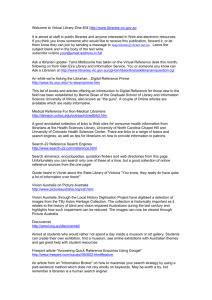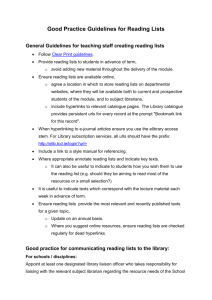The interesting lives of librarians
advertisement
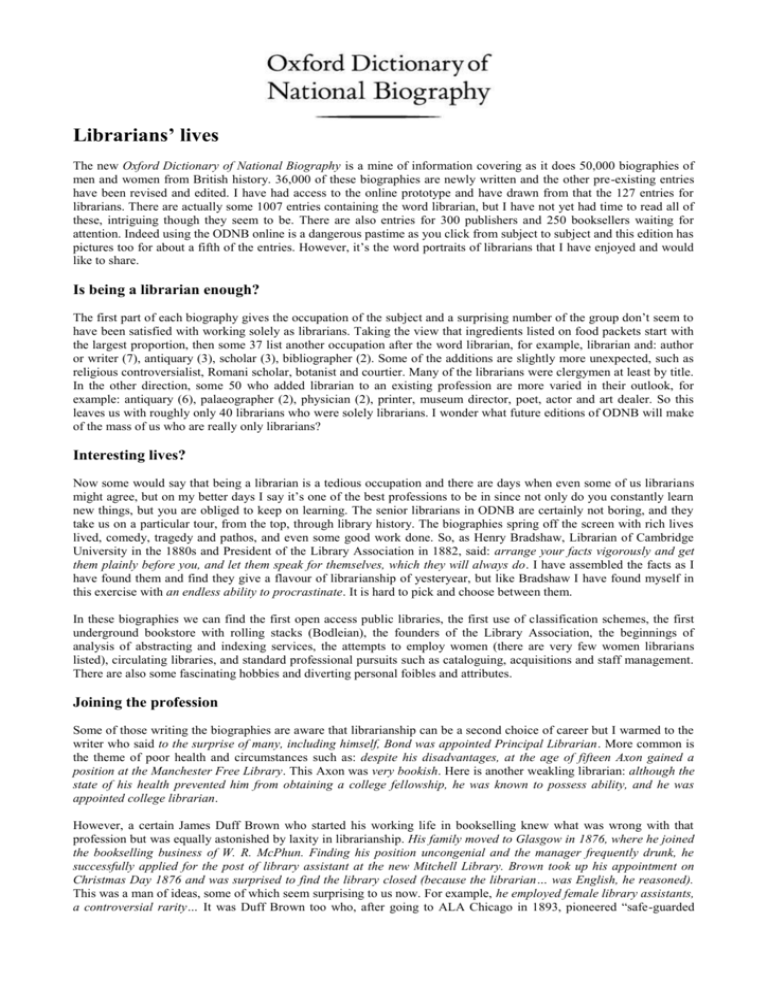
Librarians’ lives The new Oxford Dictionary of National Biography is a mine of information covering as it does 50,000 biographies of men and women from British history. 36,000 of these biographies are newly written and the other pre-existing entries have been revised and edited. I have had access to the online prototype and have drawn from that the 127 entries for librarians. There are actually some 1007 entries containing the word librarian, but I have not yet had time to read all of these, intriguing though they seem to be. There are also entries for 300 publishers and 250 booksellers waiting for attention. Indeed using the ODNB online is a dangerous pastime as you click from subject to subject and this edition has pictures too for about a fifth of the entries. However, it’s the word portraits of librarians that I have enjoyed and would like to share. Is being a librarian enough? The first part of each biography gives the occupation of the subject and a surprising number of the group don’t seem to have been satisfied with working solely as librarians. Taking the view that ingredients listed on food packets start with the largest proportion, then some 37 list another occupation after the word librarian, for example, librarian and: author or writer (7), antiquary (3), scholar (3), bibliographer (2). Some of the additions are slightly more unexpected, such as religious controversialist, Romani scholar, botanist and courtier. Many of the librarians were clergymen at least by title. In the other direction, some 50 who added librarian to an existing profession are more varied in their outlook, for example: antiquary (6), palaeographer (2), physician (2), printer, museum director, poet, actor and art dealer. So this leaves us with roughly only 40 librarians who were solely librarians. I wonder what future editions of ODNB will make of the mass of us who are really only librarians? Interesting lives? Now some would say that being a librarian is a tedious occupation and there are days when even some of us librarians might agree, but on my better days I say it’s one of the best professions to be in since not only do you constantly learn new things, but you are obliged to keep on learning. The senior librarians in ODNB are certainly not boring, and they take us on a particular tour, from the top, through library history. The biographies spring off the screen with rich lives lived, comedy, tragedy and pathos, and even some good work done. So, as Henry Bradshaw, Librarian of Cambridge University in the 1880s and President of the Library Association in 1882, said: arrange your facts vigorously and get them plainly before you, and let them speak for themselves, which they will always do. I have assembled the facts as I have found them and find they give a flavour of librarianship of yesteryear, but like Bradshaw I have found myself in this exercise with an endless ability to procrastinate. It is hard to pick and choose between them. In these biographies we can find the first open access public libraries, the first use of classification schemes, the first underground bookstore with rolling stacks (Bodleian), the founders of the Library Association, the beginnings of analysis of abstracting and indexing services, the attempts to employ women (there are very few women librarians listed), circulating libraries, and standard professional pursuits such as cataloguing, acquisitions and staff management. There are also some fascinating hobbies and diverting personal foibles and attributes. Joining the profession Some of those writing the biographies are aware that librarianship can be a second choice of career but I warmed to the writer who said to the surprise of many, including himself, Bond was appointed Principal Librarian. More common is the theme of poor health and circumstances such as: despite his disadvantages, at the age of fifteen Axon gained a position at the Manchester Free Library. This Axon was very bookish. Here is another weakling librarian: although the state of his health prevented him from obtaining a college fellowship, he was known to possess ability, and he was appointed college librarian. However, a certain James Duff Brown who started his working life in bookselling knew what was wrong with that profession but was equally astonished by laxity in librarianship. His family moved to Glasgow in 1876, where he joined the bookselling business of W. R. McPhun. Finding his position uncongenial and the manager frequently drunk, he successfully applied for the post of library assistant at the new Mitchell Library. Brown took up his appointment on Christmas Day 1876 and was surprised to find the library closed (because the librarian… was English, he reasoned). This was a man of ideas, some of which seem surprising to us now. For example, he employed female library assistants, a controversial rarity… It was Duff Brown too who, after going to ALA Chicago in 1893, pioneered “safe-guarded open access” stock in Clerkenwell public library. In 1900 Minnie James, active in both the LA and ALA, commenting on the US habit of employing women library staff compared to the lack of women in the UK, wrote that women are peculiarly fitted for such work and it is a source of great wonderment to everyone who has considered the subject that so few such women have been employed in British libraries in really responsible positions. Minnie James cared deeply for her readers and working in the People’s Palace Library in London she showed respect and sympathy for the working people who used the library by introducing Sunday opening from 3pm to 10pm. Edward Nicholson, Bodley’s Librarian in the late 1880s, was famed for the first underground bookstore with rolling bookcases, and he, too, was sympathetic to employing women. His biographer throws a couple of attributes oddly together here: He was a strong opponent of vivisection and supporter of the cause of women – his last battle with his senior colleagues and curators was over the appointment of women to the permanent staff. Collection development and circulation But what of collections and their development? Many librarians have set themselves against censorship, and in 1889 the newly elected Vice President of the Library Association, Thomas Lyster, wrote: in a great library all things, good and evil, fall into their places, are seen in the just light, and proportion, and the totality of the record of human thought and feeling is a witness for what is wholesome, true and good. Since there is little new under the sun you will not be surprised to know that in the 1600s the Bodleian Curators relied on the Frankfurt fair catalogues for their choice of acquisitions. George Harrison (of Liverpool), one of the founding members of the Library Association, wrote a paper on weeding in 1881 entitled On the elimination of useless books from libraries. The development of classification can be traced through the biographies with the task of replacing books on shelves becoming easier as the various methods of arrangement by collector, or by rough subject (or as us librarians often do at home, by colour and size) became more scientifically organized. Discrimination in what was collected was always important and as John Rouse, Bodley’s Librarian most famous for refusing to loan a book to King Charles in the 1640s, said: Mentire nescio. Librum si malus est nequeo laudare. Which roughly translates as “I cannot lie. I cannot praise a book if it is bad”. Lending books has always been problematic for librarians who like to have all their stock in order on the shelves. Samuel Fancourt devised a Circulating Library in 1735 for the entertainment of distant as well as home Subscribers. He bought books in French and English but found the people of Salisbury uninterested and moved his stock and family to London and set up a succession of lending libraries with books in French, English, and Latin. David Irving, Librarian of the Advocates’ Library in 1820, was so cross about overdue books that he stopped his staunch supporter Sir William Hamilton from borrowing books. Hamilton at that time had over 1000 volumes in his possession and had refused to return them. Cataloguing The golden age of individual catalogues is a common theme in the biographies. The librarian of the London Library from 1893, Charles Wright, had a notice in his subject catalogue office saying No guessing, no thinking. Accuracy, accuracy, accuracy! A motto that we all of course follow in cataloguing, perhaps particularly the no thinking bit! Alfred Hackman, a cataloguer in the Bodleian in the 1840s, was apparently accustomed to work sitting on top of a thick volume which, as a result, he forgot to include in the library catalogue. Samuel Ayscough, a cataloguer in the British Museum in the late 1700s, spent two years working on a catalogue of the manuscript collection, which he published privately, using to compile it some 20,000 slips of paper and two indexes. Apparently it is still indispensable but surely we’re glad that slips of paper are no longer needed for our work. He was also the first writer of a concordance to Shakespeare. Edward Bond became a Keeper in the British Museum in 1866 and, as his biography relates, at once addressed its most pressing problem, the twelve years’ arrears of cataloguing. Bond was crucial in the development and printing of the British Museum’s public catalogue, but he had other functions in the Library. Bond was used as a channel for conducting business between his department head and the Principal Librarian, Antony Panizzi, since the two were not on speaking terms. Staff Management Relations between managers and staff, and between colleagues, feature frequently and I provide here a few glimpses of the kind of thing that of course never happens in modern day practice. John Ballinger was the first librarian of the National Library of Wales from 1908. However, his dealings with staff sound less than optimal in that his lack of humour and austere sense of mission alienated many of his associates and he intimidated his subordinates. Edward Edwards who worked in the British Museum in the mid-1800s and was very important in the development of free public libraries, where he later worked, was not the best of employees. He frequently annoyed his superiors by his unpunctuality, single-mindedness, and tendency to conduct his private research in working hours. Frederic Madden who worked in the British Museum in the same era was not very fond of his line-manager and described him as always an ass; always a bully; always a time-serving, lick-spittle booby and blockhead. Perish the thought that any of us might describe our line managers in that way. Edward Thompson, also working in the British Museum in the mid to late 1800s, was a stickler for formality in his rules and relations with staff. Apart from once telling off an assistant for riding a bicycle in the street, he strictly enforced the prevailing dress code that senior staff should wear top hats in the galleries. Innovators Henry Ellis started his library career in the Bodleian and went subsequently to the British Museum where he was recorded as not being keen on extending opening hours: Evening opening would simply attract lawyers’ clerks, and persons who would read … novels, and light literatures. However, Richard Garnett, who also worked in the British Museum, was keen on innovation in the 1880s. He used photography for the copying of rare books and electric lighting for the reading room, so that opening hours could be extended. Dim light in the stacks could mask a multitude of sins and Thomas Lyster, Librarian of the National Library of Ireland, did not want to upset his staff so he would walk around the book stacks, keys in hand, calling “I’m coming, I’m coming” to avoid surprising the unwary at something they should not have been doing. The staff in the British Museum meanwhile had a way of signalling to each other, by putting one hand above the other, that one of those chaps in top hats was on their way. Other librarians notable for innovation included Stanley Jast who decided against the run of things to classify Peterborough Public Library using Dewey classification being pleased that librarianship was, as he said, one of the fine arts that … reduce chaos to order. He had a succession of public library jobs where he swept away unnecessary regulations and in Croydon in the 1890s, always a place of innovation, he introduced the telephone, which was unheard of in most libraries. Would that telephones were never heard in libraries nowadays! The professional librarian? If you were the most knowledgeable librarian in the Foreign Office as apparently Lewis Hertslet was in the first half of the 19th century you might well be known as a Walking State Paper. Thomas Jamieson, Keeper of the Advocates’ Library in Edinburgh, was described in a reference from his former chief as a “born librarian”. However, Jonas Dryander, Swedish born Librarian to the Linnean Society in 1802, was described by Bishop Goodenough as a dull plodding genius. The bishop, who I hope does not get his own entry in the ODNB, further conceded that plodding was the first quality of a librarian. How can we describe as plodding the career of Eric Dingwall who worked in Cambridge University Library from 1915 and who included in his many unusual interests, conjuring and aberrant sexual customs? It is to him we owe much of the contents of the “private case” of erotic material in the British Museum, to which he added at his own expense when he later worked there. Others were apparently not so good at their jobs. Charles Morton who worked at the British Museum from 1756 was described as a man of sedentary habits, extremely idle, disposed to let things run on from day to day. John Hudson, Bodley’s librarian from 1701, had a reputation as a negligent if not incapable librarian. Nicknamed “the Bookseller”, Hudson apparently confused his own book business with his responsibilities as librarian. John Price, Bodley’s librarian from 1768, was attacked for a regular and constant neglect of his duty. Price appointed his godson Bulkeley Bandinel to be under-librarian at the Bodleian and once he gained the top job Bandinel acted quickly. Within four months the Bodleian statutes were altered to increase its staff, its annual grant, its opening hours, and its librarian’s salary. This is probably why all staff trembled when he approached. Sadly, at the end of his career it is recorded that his attendance at the library declined, but he clung to office, resisting change, while his governing body of curators turned increasingly to his subordinates. Arthur Cowley, Bodley’s Librarian from 1919, had a career chiefly characterized by his desire to see a unified library management system in the university but as time went by he became more and more taken up with congresses, conferences and international boards. Poetry and Librarianship David Laing who was first a publisher and bookseller in Scotland was described in a contemporary poem in the Edinburgh Magazine in 1818 as: A famous Bibliomaniac, and a shrewd, Who turns his madness to no little good. The retirement of Henry Tedder, Librarian of the Athenaeum, inspired Kipling’s poem To a Librarian. However, the most famous link between poetry and librarianship must surely be the career of Philip Larkin, Librarian of the University of Hull from the mid 1950s. I found his entry somewhat lacking in vigour and would like to quote here something from his letters. This is part of a letter written in 1985 to Barry Bloomfield, a marvellous librarian in the British Library, who I hope will appear in a future DNB: I met our new VC (Vice Chancellor) for half an hour; he seemed to know much more about libraries than I liked, and computers too. His first question was “What’s your payroll / nonpayroll breakdown?” I said “Oh, mind your own fucking business,” not out loud of course. I should think it’s about 65/35. But what d’you expect with periodicals cuts all the time, and chaps sitting on their arses? I shall be truly amazed if I’m still in post this time next year. Or alive even. Best of luck with restructuring- Love, Philip. (Selected letters of Philip Larkin edited by A. Thwaite) Colourful lives and deaths William Ralston, an assistant at the British Museum, taught himself Russian from dictionaries, but his attempts to visit Russia were generally cancelled. He complained of rheumatism, dyspepsia, roaring in the ears, perpetual sleepiness and he was finally found dead in 1889, after trying to overcome depression with narcotics, with a gutta-percha sheet over his head and a bottle of chloroform in his hand. Thomas Lockey, Bodley’s Librarian from 1660, died in 1679 of a surfeit of cherries. I can think of worse deaths, but then I do not think I shall be asking to have my ashes scattered in the library’s grounds, as have others. Many librarians were obliged to live on the premises and modern readers may find it hard to understand this when reading that a librarian died in their lodgings in the library. My own predecessors were obliged to live on site and the first Taylor librarian from 1848 to 1871, William Macray, who gets a brief mention in ODNB, was reputed on cold nights to sleep on the broad mantelpiece in the main reading room, the dying embers of the fire providing the single source of warmth in the building. His successor, Heinrich Krebs, Taylor Librarian from 1871 to 1921, did not like to pack his hats when travelling so wore them all at once when on the train to Germany to visit his family, carrying along with him the written permission of the Taylor Curators to leave Oxford. We know this from his daughter’s memoirs. She was born in the library, but was not a “born librarian”. Eccentricities of course exist in every profession and I will finish with a description of the garden of Francis Wise, an Oxford Librarian in the first half of the 18 th century. He created an elegant garden on rented land with ponds, cascades, seats, a triumphal arch, the tower of Babel, a Druid temple, and an Aegyptian pyramid …created in exact scale and measure – but fortunately in miniature. Interesting lives indeed. I wonder if they would have dreamed of being captured, stored and searched for on computers? Actually one of them would, but that’s another story you can find on the ODNB. Liz Chapman Taylor Institution Librarian University of Oxford Library Services July 2003
